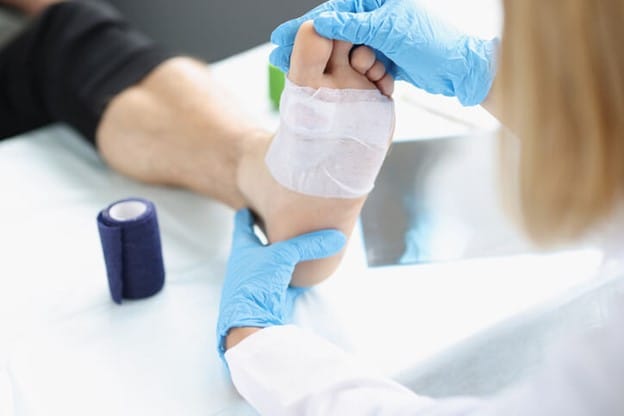
There are many different ways that you can develop an injury to your upper or lower extremities. While some injuries will resolve on their own or can be easily treated with rest, ice or heat therapy, and pain medication, others may worsen or develop complications. Limb injuries that include cuts, abrasions, or open sores or wounds are much more susceptible to complications, especially if you aren’t able to properly care for the wound yourself.
When you work with a certified wound care specialist, you can reduce your risk of extremity wound complications. Let’s take a look at new treatments for limb injuries, how to promote advanced healing and optimal recovery, and the latest innovations in extremity wound care technologies in Portland, OR; Los Angeles, CA; Vancouver, WA; and Nashville, TN.
An upper or lower extremity injury affects any of the limbs in your body. This could include an injury, damage, or trauma to your shoulder, arm, elbow, forearm, wrist, hand, hip, thigh, knee, ankle, or foot. These types of injuries can include lacerations or incisions, abrasions, avulsions, fractures, sprains, strains, discolorations, nerve injury, tendon tears, or soft tissue damage. They can be caused by abuse, assault, trauma, falls, car accidents, work accidents, sports accidents, repetitive stress, or overuse. Without treatment, an upper or lower extremity injury may get worse and can cause permanent pain, discomfort, loss of range of motion, and other complications.
Professional wound care is the assessment, treatment, and management of a wound by a healthcare professional who has undergone specialized education and training. A certified wound care specialist is certified by the American Board of Wound Management and can manage and treat complex or non-healing wounds, including extremity wounds. A CWS will provide highly personalized wound care, education and instruction on proper wound care, and tips for preventing complications. They utilize state-of-the-art technology and advanced healing methods, such as debridement, negative pressure wound therapy, or hyperbaric oxygen therapy.
When you work with a certified wound care specialist, you will have access to advanced healing therapies, innovative and modern wound care techniques, education and instruction on proper wound care, and a collaborative care plan that improves healing and recovery and restores quality of life. The biggest benefits of working with a CWS to develop an upper or lower extremity wound care treatment program are:
While many extremity wounds can be treated effectively using conventional wound care techniques, others may require a more innovative or modern approach. A certified wound care specialist can integrate the latest extremity wound care technologies into your treatment plan if they determine that you may have a non-healing or chronic extremity wound. The most effective new treatments for limb injuries are:
Managing chronic wounds is more challenging than wound care for acute or minor wounds. Using conventional methods may not be as effective if you have a chronic extremity wound. Newer treatments for limb injuries can accelerate healing and reduce the risk of infection and other complications. Nanotherapeutics are therapeutic drugs and devices that are designed, created, and managed at the nanoscale level and used to improve the delivery of drugs to specific cells. Because nanoparticles are so small, nanotherapeutic drugs can penetrate deeper into injured skin and work more quickly to jumpstart the healing process. Nanotherapeutics present an innovative and advanced healing protocol that combines stem cell therapy, phototherapy, microbiome therapy, reactive oxygen species, and NO generators. These biological therapies can promote enhanced wound healing with the use of different nanomaterials that are infused with antimicrobial agents. Nanotherapeutics allow for a more controlled, precise, and concentrated delivery of these antimicrobial agents to the wound site. This can overcome different obstacles that are delaying wound healing. Nanotherapeutics can control infection and inflammation and improve cell regeneration and tissue healing. Burn wounds and diabetic wounds are particularly suited for treatment with nanotherapeutics.
Stem cell therapy is a regenerative medicine protocol that uses alternative therapies to restore skin health, promote wound healing, and jumpstart the regeneration of cells and tissues. Stem cell therapies have shown promise in treating chronic or non-healing wounds of the upper or lower extremities. During stem cell therapy, stem cells are obtained or harvested and then transplanted into the site of the wound. As the body responds to the introduction of stem cells, it stimulates the release of growth factors and cytokines that promote wound healing. Stem cell therapy can restore damaged tissues to a healthy state, reduce inflammation, promote oxygenation and immune response, and promote angiogenesis or the growth of new blood vessels. While it can take weeks to see results, the results can be significant.
Bioprinting is a state-of-the-art technology that uses 3D printing to create tissue constructs that can help wounds heal. Healthy cells are mixed with a hydrogel, and then a bioprinter scans the wound and then deposits cells, growth factors, and other biomaterials directly into the wound. The bioprinter uses advanced imaging technology to determine optimal delivery sites for the cells. Bioprinting can also create complex tissue constructs that mimic the structure and appearance of natural tissue. These constructs can be fully customized to promote healing. Bioprinting can also be used to deliver stem cells and antimicrobial agents to further facilitate wound healing.
The extracellular matrix is a network of proteins and molecules that promote wound healing. The ECM provides structure to cells and tissues and modulates cell behavior. It can encourage adhesion, migration, and proliferation and release growth factors that improve wound healing. ECM is used in all stages of wound healing, including hemostasis, inflammation, proliferation, and remodeling. It is also a component of granulation tissue and scar tissue. In chronic wounds, healing is delayed or stalled due to problems with the ECM. Advanced wound healing therapies use ECM-based strategies to jumpstart healing. These strategies include the use of bioengineered tissues or synthetic ECM structures to promote wound healing. These structures can regenerate cells, deliver growth factors, and provide mechanical support to encourage wound closure. They mimic natural ECM structures and can create a more stable, sterile environment for wound healing.
Platelet-rich plasma (PRP) therapy is a blood-based therapy that can help wounds heal with the use of the body’s own platelets and growth factors. For chronic or slow-healing extremity wounds, PRP therapy can encourage wound healing and reduce the risk of infection or other complications. During PRP therapy, the patient’s blood is drawn from their arm and put into a centrifuge to separate the platelets from the other blood components. The PRP is then injected into the wound to promote healing. PRP therapy is especially effective at treating chronic and slow-to-heal wounds, such as diabetic ulcers, venous ulcers, arterial ulcers, and pressure ulcers. It can reduce inflammation, reduce reliance on pain medications, optimize the body’s inflammatory response, and reduce the risk of infection.
Cold plasma therapy is a medical treatment that uses partially ionized gas, or cold plasma, to accelerate recovery and wound healing. This gas can kill bacteria in the wound, reduce the risk of infection, and promote collagen production, tissue and cell growth, and blood vessel formation. This creates an ideal environment for tissue healing. Cold plasma therapy is minimally invasive and is especially effective for chronic or non-healing extremity wounds like diabetic foot ulcers. Cold plasma therapy is administered with a handheld device that is applied directly to the wound site. It is most suitable for chronic wounds of the upper and lower extremities.
A certified wound care specialist who has experience in treating and managing upper and lower extremity wounds can help you explore innovative new treatments for limb injuries. They stay up to date on the latest innovations and state-of-the-art technology and have access to advanced wound care techniques. They will work closely with you and your care team to identify underlying issues that could affect your wound healing or increase your risk of complications and develop a wound care plan that relieves pain and discomfort, promotes recovery and healing, prevents complications, and improves quality of life.
At BH Wound Care, we have a team of certified wound care specialists with advanced knowledge of the treatment of chronic or slow-healing extremity wounds. We specialize in the assessment, treatment, and management of wounds to the upper and lower extremities caused by pressure sores, ulcers, abrasions, avulsions, trauma, surgical incisions, and more.
We provide wound assessments and wound care to patients in their homes, via telemedicine, and in assisted living, long-term care, and memory care facilities. Our goal is to provide highly individualized wound care that relieves pain and discomfort, promotes healing, reduces the risk of infection, and improves quality of life. Call us now or reach out to us online to schedule a consultation for extremity wound care in Portland, OR; Los Angeles, CA; Vancouver, WA; or Nashville, TN.

Struggling with a non-healing wound can be incredibly frustrating, but you don’t have to face it alone, BH Wound Care has you covered.
By harnessing the power of advanced, evidence-based medical technologies, we aim to expedite the healing process, helping you get back to your life wound-free. Our ultimate goal is to achieve complete healing for every patient we serve.
Our highly trained specialists work in tandem, ensuring comprehensive care. Whatever your requirements, we’re here to help you through every step of the healing journey, from handling referrals to insurance authorizations and beyond.
With regular follow-ups and unwavering support, we keep a close eye on your progress, ensuring the quickest possible recovery.
Don’t let non-healing wounds hold you back any longer. Experience the difference at BH Wound Care and rediscover a life without limitations.
